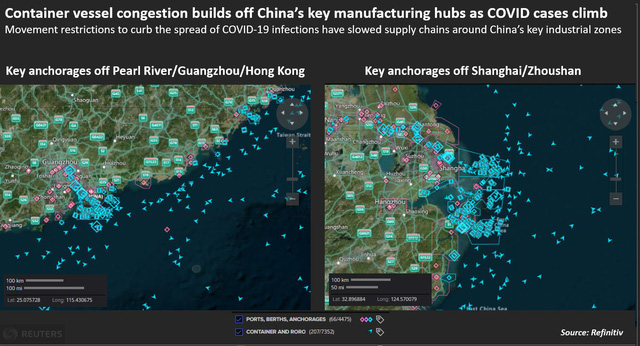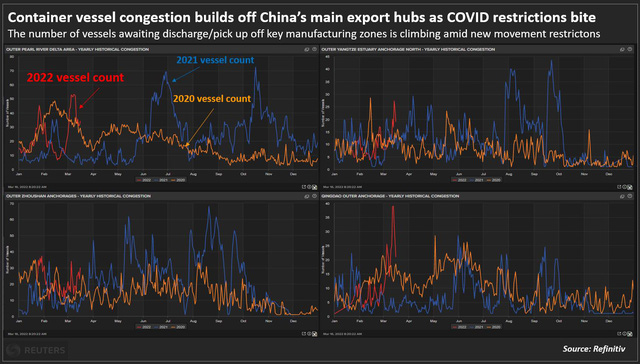The global supply chain is in jeopardy again when China’s seaports are congested because of the Covid-19 outbreak
China is having the most spike in Covid-19 infections since the first outbreak, in early 2020 in Wuhan city.
The rapidly spreading Omicron variant virus has led to strict controls across the country, including in key manufacturing hubs in Shenzhen and Dongguan, crippling factories producing goods. , from flash drives to car parts.
According to ship owners, analysts and supply chain managers, while China’s main ports remain open and ships continue to dock, congestion is increasing and some container ships are rerouting. to avoid the almost certain delay. They said the charter price will likely increase, while the total shipping time will be longer.

Ship congestion in China’s main manufacturing hubs due to the new outbreak of Covid-19.
Supply chain crisis
Jasmine Wall, Asia-Pacific director of shipping company SEKO Logistics, said that container handling is “massively decreasing” at Shenzhen’s Yantian port, the world’s fourth-largest container port. by port workers, truck drivers and factory workers at home.
Lars Jensen, CEO of the freight consulting firm Vespucci Maritime, said: “This shows that it will become difficult to move cargo to and from Chinese ports, and therefore to the Whether the terminal is open or not will become an issue.” The current state of affairs “will have the effect of disrupting the supply chain – thereby prolonging the current supply chain crisis,” he said.
As of Wednesday (March 16), there were 34 ships off the coast of Shenzhen waiting to dock, compared with an average of seven a year ago, according to Refinitiv vessel tracking data. In Qingdao, a port city in eastern China, there are about 30 ships waiting to dock, compared with an average of seven in the same period last year.
Charter rates per 40-foot container remain close to all-time highs on major global shipping lanes, trading at around $16,000 for the China-US West Coast service, and close to $13,000 from China to Europe, according to the Freightos shipping index.

Global container shipping rates are still near record highs on major routes.
Risks
Similar anti-Covid-19 lockdowns in China in 2021 have resulted in operations at Yantian port being cut to just one-third of capacity, causing more severe global shipping disruptions than those at the port of Yantian. with the incident due to the Suez canal being closed for 6 days last year, after the container ship Ever Given ran aground, according to the director of Maersk, the world’s largest container shipping company.
Although supply chain experts say China’s ports are now better able to cope with staff shortages and transport disruptions, there are concerns that Yantian may have to close if the situation virus transmission and limited spread related to the Covid-19 epidemic.
According to the JP Morgan Global PMI, supplier and shipping delays, while still high, fell to their lowest levels since early 2021 in February 2022.
“If the (Yantian) port is closed, the unusual effect of it reopening would be a waste of all the progress made in the country,” said Bjorn Vang Jensen, vice president of consulting firm Sea-Intelligence. American ports”.
Even with ocean freight terminals open, the lack of truck drivers and warehouse operators means there will still be delays in loading shipping containers and bringing them in. go to Port.

Container ship congestion comes from China’s main export hubs due to restrictive regulations against Covid-19.
Increase inflation
Other neighboring export hubs are also experiencing congestion, including Hong Kong and Shanghai, where ships may have to wait until congestion eases to load and unload and that means Phones, TVs and toys will take longer to arrive from China to the US, said Peter Sand, director of commodity analytics company Xeneta.
“I think consumers in the US and those that ship goods to North America will be hit the hardest,” Sand said.
Shipping lines are also facing the possibility of a further rapid increase in the number of Omicron variant infections in China, as seen in other parts of the world. That, if happening, could lead to broader disruptions and impact global inflation, which has already been so high.
“The Chinese authorities’ zero-tolerance policy seems to suggest the possibility of further blockades,” said Niels Rasmussen, shipping analysis director at BIMCO Shipowners Association. “Decelerating Chinese exports will exacerbate supply chain delays and reduce the stockpiles that businesses hold, which in turn can drive prices up,” he said.
Reference: Refinitiv
at Blogtuan.info – Source: cafebiz.vn – Read the original article here



